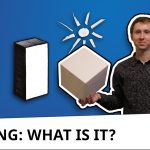Shading, turns of form and the laws of lighting, part two
Video lesson: How and why light and shadow are formed on objects (shading and turns of form) – the laws of lighting, part two, summary:
- Whether a flat surface is shadowed or lighted is determined by how much the surface is turned towards the light source.
- If we do not have a flat surface but an angular one (for example, the surface of a cube), it’s like we have several flat surfaces connected at different angles. We know how flat surfaces are lighted, so it is clear how and why each surface of the cube is lighted.*
- Usually an object consists of a big number of differently directed surfaces. As they are differently directed towards the light source, some of them are lighter and some are darker.
- Those places where the flat surfaces are connected, or in other words, the places where surface abruptly changes its direction, are known as “break of form” or “turn of form”. By knowing where on objects these breaks of form are, you will know where to expect an abrupt change in the level of light on the form.*
- Objects with a gradual smooth change in the direction of the surface light gradually and smoothly turn into shadow.*
- You are not obliged to convey all scratches and unevenness of the object’s surface. To do that or not depends only on your ideas.
- In a nutshell, the theory’s purpose is that you can draw any lighting you need with it. You are not bound to what you see or to a photo anymore. It’s very handy when you need to turn an object in the image or to move it (for example, to turn a building in the drawing, or to place a table somewhere else in a room or to change the pose of a human).
Additional info:
2*Techies sometimes like to think in terms of the intersection of infinite planes, not in terms of limited flat surfaces.
2**In some cases the parts of an angular surface can give a reflection on each other, for example, when the light is lighting the inner surface of a form in the shape of “П”. Knowledge that light travels in straight lines and reflects from glossy surfaces with an angle equal to the angle of incidence (and scatters at many different angles from matte surfaces, depending on a particular surface’s characteristics), allows us to easily take this into account. Or simply observe it with your own eyes in nature.
4* But a turn of form is not always an edge. There are no edges on the hand, while there are breaks of form on it – places where the character of lighting is changed by the changes in the direction of the surface. So a turn of form can look smooth on smooth surfaces.
5* Sometimes surfaces of objects curve gradually. After drawing such surfaces a couple of times and looking at them in real life at the same time, and after drawing a sphere and cube a couple of times you’ll understand the principle of shading on such surfaces.
Essentially, the curved surfaces can be divided into many small flat surfaces, like a sphere can be modeled as a soccer ball with its pentagrams. If you do this, it will be clear why the shading on a curved surface is exactly like this. You can divide any surface like this.
In some cases, you can do that in your imagination, and in some cases you will know how from your previous experience. After drawing basic geometric forms several times, you’ll be able to draw their flattened and oblong forms. In some cases, you’ll need to think hard about the construction (see the next lesson), but you will always be able to do that.
5**
The from a light source is also important: the further from the source, the weaker the light is light from it. This creates a gradual gradient of tone from lighter to darker on a surface. This happens because the rays fly in every direction from the lamp bulb, and the light is “denser” closer to it. That is, if you form a ring with two fingers, it will catch more rays closer to the lamp. The Sun is very far from Earth so its rays are practically parallel. That’s why in the case of direct light from window or outdoors, there is no such effect.
5*** You should know that the areas of light, middle tone and core shadow very rarely have really sharp borders between them, so these are only conventional areas, just names. In real life there is usually only gradation from the lightest part to the darkest part of the object. This happens because the surfaces of the objects are smooth and at a microscopic scale they change their direction very gradually, so their tone changes gradually. That means that if we have a tone from middle tone and a tone from a shadow, there will always be an infinite number of intermediate tones between them, which will gradually get darker till it reaches the tone of the shade. If the tones are very similar, we can magnify it and see the intermediate tone. Just remember that the surface of the object gradually changes its direction. Generally, only a cube and such angular shapes have sharp borders of shadow and light.
The next part is about how all this is connected with drawing complex objects



